1913 items found
Page 119 of 160
-
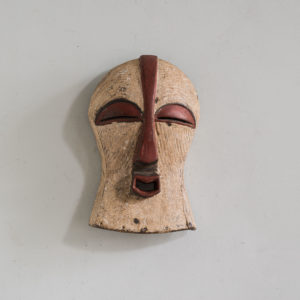
Luba Bilume Kifwebe mask (A)
£175Luba Bilume Kifwebe mask (A)
The people of Songye are mainly known as a farming community, however they also take part in hunting and trading with other neighbouring communities. The distinct Songye style is easily recognisable in the Kifwebe mask by the mass of closely carved lines and bold shapes such as the protruding sagittal crest and X carved mouth. The intertwining of the red, black, and white colouring in these masks are said to symbolise the struggle between good (white) and evil (black and red) – the combination of these colours embodying the positive and dangerous force held within the mask. Further, it is believed that the sagittal crest and conical protrusion contain the magical strength of the mask.£175 -

Songye Luba mask (A)
£280Songye Luba mask (A)
The people of Songye are mainly known as a farming community, however they also take part in hunting and trading with other neighbouring communities. The distinct Songye style is easily recognisable in the Kifwebe mask by the mass of closely carved lines and bold shapes such as the protruding sagittal crest and X carved mouth. The intertwining of the red, black, and white colouring in these masks are said to symbolise the struggle between good (white) and evil (black and red) – the combination of these colours embodying the positive and dangerous force held within the mask. The ruggedness of the Kifwebe mask and its long raffia beard are said to symbolise the underworld and the spirits that escape from it. Further, it is believed that the sagittal crest and conical protrusion contain the magical strength of the mask.£280 -
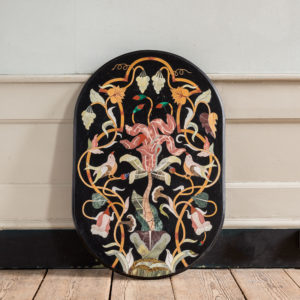
Pietra Dura marble table top
£1,500 -
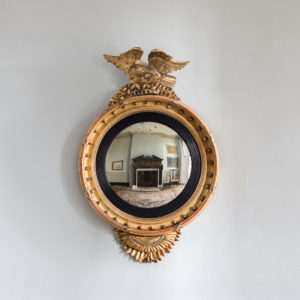
Regency gilded convex mirror
£3,250Regency gilded convex mirror
surmounted by cresting of an eagle perched and poised on rocks, the circular frame with balls and delicate lambrequin mould, a generous reeded and ebonised slip within and surrounding the original convex mirror-plate.£3,250 -
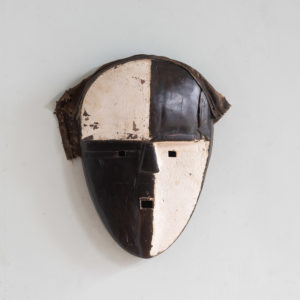
Kusu Nsembu mask
£250Kusu Nsembu mask
The Nsembu mask was used exclusively by members of the Nkunda Secret Society for the purposes of adult initiation and divination; the mask representing the diviners spirit. The chequered pattern may represent the interaction of opposites – day and night, man and woman, good and evil – within ones spiritual journey. It is also reminiscent of certain scarification practices. The Kusu people inhabit the Ituri rainforests, located in the northeastern part of the Congo.£250 -
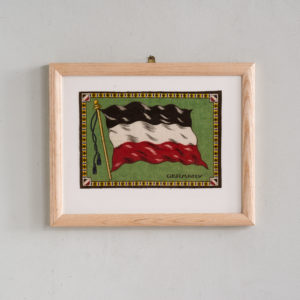
Felt Flags
£95Felt Flags
It was between 1905 and 1910 that tobacco companies in America, began inserting textile items into their cigarette and tobacco products at a time when there was much competition between the tobacco companies and advertising was important to entice new customers, and build brand loyalty. This may have been a direct marketing strategy to entice women into smoking cigarettes, as women were encouraged to gather up these small textiles inserts from spouses or friends and sew them into useful and beautiful items for the home, including quilts, pillows and table covers.£95 -
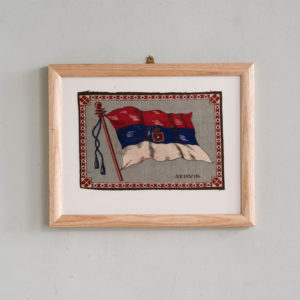
Felt Flags
£95Felt Flags
It was between 1905 and 1910 that tobacco companies in America, began inserting textile items into their cigarette and tobacco products at a time when there was much competition between the tobacco companies and advertising was important to entice new customers, and build brand loyalty. This may have been a direct marketing strategy to entice women into smoking cigarettes, as women were encouraged to gather up these small textiles inserts from spouses or friends and sew them into useful and beautiful items for the home, including quilts, pillows and table covers.£95 -

Felt Flags
£95Felt Flags
It was between 1905 and 1910 that tobacco companies in America, began inserting textile items into their cigarette and tobacco products at a time when there was much competition between the tobacco companies and advertising was important to entice new customers, and build brand loyalty. This may have been a direct marketing strategy to entice women into smoking cigarettes, as women were encouraged to gather up these small textiles inserts from spouses or friends and sew them into useful and beautiful items for the home, including quilts, pillows and table covers.£95 -
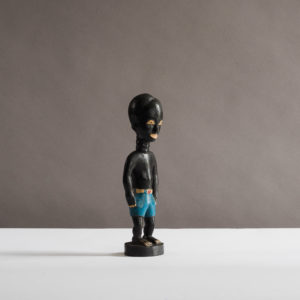
Baoulé Colon figure,
£50Baoulé Colon figure,
African colon figures originated among the Ivory Coast’s Baoulé tribe as an often satirical artistic response to colonisation and European influence. The hand-carved wooden statues involve at least three craftsmen: the sculptor, the sander, and the painter. They commonly depict a Europeanised African middle class, or stereotypical attributes of European design – official uniforms, suits, tobacco pipes, distinct hairstyles and hats. The Baoulé waged one of the longest wars of resistance against French colonisation, and the colon style would achieve international popularity following the second World War. The male figure stands slumped slightly forward, wearing nothing but a pair of brightly coloured blue shorts and belt. European missionaries would encourage African people to ‘cover up’ in order to instil concepts of puritanism and purdor.£50 -
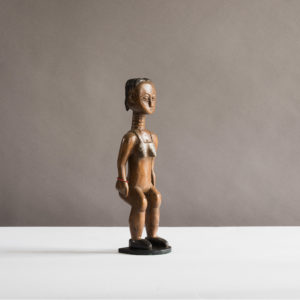
Baule Colon figure,
£50Baule Colon figure,
African colon figures originated among the Ivory Coast’s Baoulé tribe as an often satirical artistic response to colonisation and European influence. The Baoulé waged one of the longest wars of resistance against French colonisation, and the colon style would achieve international popularity following the second World War. Their hand-carved wooden statues commonly depict a Europeanised African middle class, or stereotypical attributes of European design – official uniforms, suits, tobacco pipes, distinct hairstyles and hats. The female figure wears a Europeanised hairstyle, her breasts hidden by a bikini-style top. European missionaries would encourage African people to ‘cover up’ in order to instil concepts of puritanism and purdor.£50 -

Tabwa stool
£350Tabwa stool
Congolese Tabwa art has distinct similarities to that of the Luba tribe, and its stools are used also in ceremonies by the Kings and Chiefs of the community with a means of establishing power and authority. The key difference seen between the two is the Tabwa’s traditional depiction of braided hair as a carved extension of the head and checkerboard-style scarification of the woman’s body.£350 -
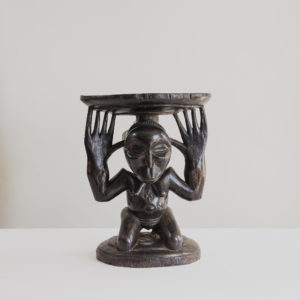
Luba stool,
£300Luba stool,
Luba art relates most commonly to the Kings and Chiefs of the Congolese Luba tribe, who would assert their power by display of ceremonial objects during ceremonies. Stools were considered to be the most important of these objects as they would serve not only as a seat but as a receptacle for the Chief’s spirit. The ruler is thus figuratively and literally supported by a caryatid figure – in this case a kneeling female ancestor with elongated and outstretched fingertips. The deep and patterned carvings seen on her stomach allude to the maternal – such markings were common among many matrilineal societies in Africa to emphasise and protect the navel as the threshold between oneself, one’s mother and one’s own lineage.£300
